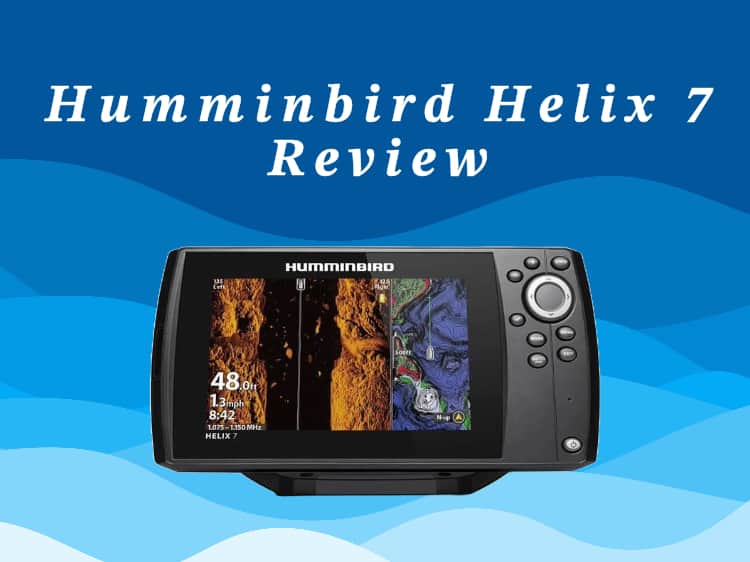Humminbird Helix 7 series includes several variants, each with a different combination of features tailored to the needs of anglers and boaters. This review is focused on the Helix 7 CHIRP Mega SI GPS G4/G4N model. We will briefly touch on its other models as well.
The Humminbird Helix 7 CHIRP Mega SI GPS is a high-performance fish finder and GPS combo known for its advanced technological features.
One of its standout characteristics is the Mega Side Imaging (Mega SI) technology, which provides exceptionally clear and detailed underwater images, greatly enhancing the ability to locate fish, structure, and contours.
The unit boasts a 7-inch widescreen display offering excellent clarity and visibility, even in bright sunlight, which is crucial for outdoor use.
Additionally, it includes GPS mapping capabilities, allowing anglers to navigate and mark spots with precision. The interface is user-friendly, with quick-select buttons simplifying navigation between different screens and settings.
Despite its advanced features, the Helix 7 Mega SI has some limitations, such as incompatibility with Mega 360 Imaging unless upgraded to a larger model.
Overall, it is one the best Humminbird fish finder tailored for anglers looking to enhance their fishing experience with detailed sonar and mapping capabilities.
Key Specifications:
| Specification | Details |
| Display Size | 7 inches |
| Screen Resolution | 1024H x 600V pixels |
| Sonar Technology | Dual Spectrum CHIRP, Mega Down Imaging, Mega Side Imaging |
| Depth Capability | Up to 1,200 ft (365 m) standard, 3,500 ft (1,067 m) with optional 50 kHz transducer |
| GPS Capabilities | Built-in GPS |
| Mapping | Humminbird Basemap, compatible with LakeMaster and Navionics |
| Power Output | 500 Watts (RMS) |
| Frequency | 50/83/200/455 kHz & 1.2 MHz (Mega Imaging) |
| Memory Card Slot | Dual Micro SD card slot |
| Networking | Bluetooth, Ethernet (on G4N models) |
| Waterproofing | IPX7 rated |
| Price | $949.99 USD |
Pros:
- High-Quality Imaging: Mega Down and Side Imaging provide superior underwater detail.
- Versatile Sonar Capabilities: Supports Dual Spectrum CHIRP for a wide range of sonar options.
- Intuitive User Interface: Easy to navigate menus and settings.
- Bright, Clear Display: Good visibility even in direct sunlight.
- Built-In GPS and Mapping: Useful for navigation and marking fishing spots.
- Networking Options: Bluetooth and Ethernet capabilities in G4N model for sharing data.
Cons:
- Price: Might be considered expensive for casual anglers.
- Size and Portability: At 7 inches, it’s less portable compared to smaller models.
- No Touchscreen: Some users may prefer a touchscreen for ease of use.
Display Quality
The display quality of the Humminbird Helix 7 is highly regarded. It features a 7-inch screen with a resolution that provides clear, sharp images, which is particularly beneficial for interpreting sonar data and maps. The screen’s brightness and clarity are effective even in direct sunlight, ensuring good visibility in various outdoor lighting conditions. This high-quality display is essential for distinguishing between underwater structures, fish, and other features.
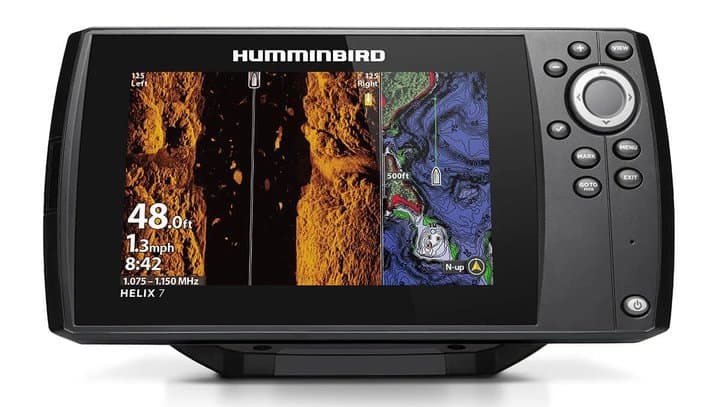
User Friendly Interface
Using the Helix 7’s interface while fishing is generally user-friendly and intuitive. Navigating through its menus and accessing different features is straightforward, which is advantageous while fishing, as it minimizes the distraction and time spent adjusting settings.
The interface is designed to be simple yet functional, allowing anglers to quickly switch between sonar, Down Imaging, Side Imaging, and GPS/chartplotting modes. This ease of use ensures that anglers can focus more on fishing and less on operating the device. Additionally, the customizable options allow users to tailor the interface to their specific needs and preferences, further enhancing the fishing experience.
Sonar Performance
The sonar performance of the Helix 7 CHIRP Mega SI G4 is excellent, particularly due to its advanced technology. Here is a quick look at the types of sonar it offers:
- Side Imaging: Frequencies of 455 kHz (with a depth range of up to 400 feet on each side of the boat) and Mega SI at 1.2 MHz (with a depth range of up to 125 feet on each side).
- Down Imaging: Frequencies of 455 kHz and Mega DI at 1.2 MHz, with depth range of 400 feet (@ 455 kHz) and 125 feet (@ 1.2 MHz) below the boat.
- Dual Spectrum CHIRP Sonar: Offers a Full mode (150-220 kHz) and a Narrow mode (180-240 kHz), with depth ranges that can extend up to 1,200 feet in freshwater with high accuracy and detail.
Side Imaging
Humminbird is widely recognized for offering the best Side Imaging technology in the industry, particularly with their MEGA Side Imaging feature. The benefits and usefulness of MEGA Side Imaging in Helix 7 include:
- Detailed Underwater Images: Mega SI provides extremely high-resolution images of the underwater environment. This clarity enables anglers to see finer details like small fish, distinct features of the bottom structure, and even individual rocks and submerged vegetation with greater precision.
- Wide Coverage Area: The technology scans a broad area on either side of the boat, giving anglers a comprehensive view of the underwater terrain. This wide coverage is particularly useful for quickly scanning large areas to locate fish and structures.
- Better Target Identification: The enhanced detail from Mega SI helps in distinguishing between different types of underwater structures and fish. Anglers can identify potential hotspots and fishing areas more effectively.
- Ideal for Shallow Water: Mega SI is highly beneficial in shallow water scenarios where traditional down imaging might not be as effective. It’s great for scouting the edges of lakes, rivers, and in areas with lots of submerged structures like logs, rocks, and weeds.
- Aid in Navigation: Besides locating fish, it’s also useful for navigating in unfamiliar waters, helping to avoid potential hazards and identifying safe paths.
Below is the screenshot of Helix 7 side imaging sonar. The image quality is quite clear, showing the potential capabilities of Mega Side Imaging to reveal detailed underwater structures and fish locations, which would be a valuable asset for an angler.
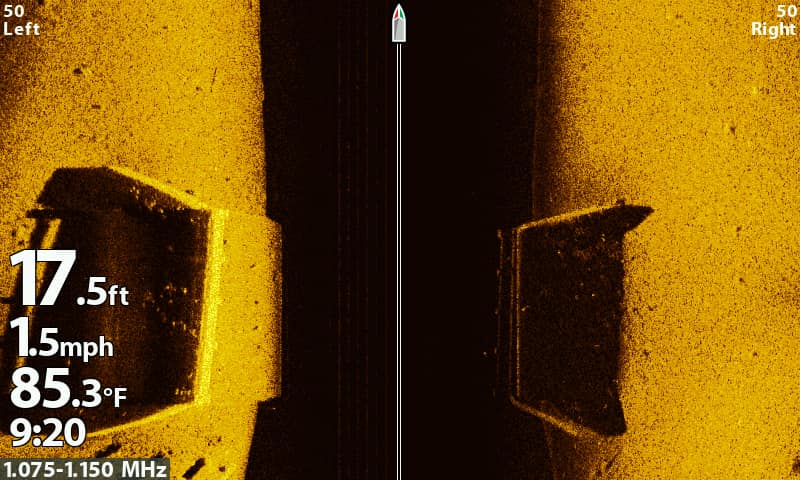
Down Imaging
The Mega Down Imaging in the Helix 7 provides exceptional clarity and a detailed underwater view.
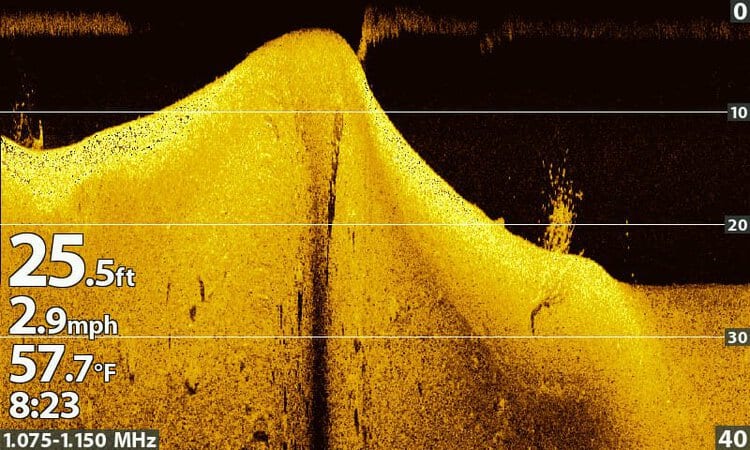
It provides anglers with a significant amount of assistance in fishing by:
- High-Resolution Imaging: The Mega Down Imaging feature provides exceptionally clear and detailed images of what’s directly beneath the boat. This high resolution is instrumental in distinguishing between different types of underwater structures, vegetation, and fish.
- Enhanced Fish Detection: Due to its clarity, Mega Down Imaging makes it easier to identify fish, even when they are near the bottom or close to structures. This precision helps anglers in targeting specific species and understanding fish behavior.
- Better Understanding of Bottom Composition: It gives a vivid picture of the bottom landscape, including contours, rocks, weeds, and other features. This knowledge is crucial for anglers to choose the right bait and technique for the type of bottom they are fishing over.
- Useful in Various Water Conditions: Whether in clear or murky waters, the Mega Down Imaging maintains its effectiveness, providing valuable insights in different fishing environments.
- Aid in Precise Bait Placement: Knowing the exact underwater structure helps anglers in placing their bait more accurately, increasing the chances of a catch.
CHIRP Sonar
The Dual Spectrum CHIRP sonar in the Humminbird Helix 7 is well-regarded for its superior performance. This sonar technology provides enhanced detail, better target separation, and greater depth capability than traditional single frequency sonar.
With Dual Spectrum CHIRP, anglers can customize the sonar returns by selecting either a wide mode for a larger search area or a narrow mode for more detail. This versatility allows for a more refined fishing strategy, helping to identify fish targets and structure with precision.
The clear and detailed feedback that CHIRP technology provides is a significant advantage for both casual and serious anglers, making the Helix 7 a popular choice for its sonar capabilities.
GPS and Mapping
The GPS and mapping features of the Humminbird Helix 7 are highly appreciated by anglers for their accuracy and user-friendliness. The GPS combo provides quick and reliable positioning, which is essential for navigation and for marking fishing hotspots, waypoints, and tracks. With its precision, anglers can return to specific locations with ease.
The mapping capabilities of the Helix 7 are also robust. It comes pre-loaded with Basemaps that offer a good level of detail, and there is also the option to upgrade to more detailed maps like Humminbird’s LakeMaster or Navionics for enhanced contours and points of interest.
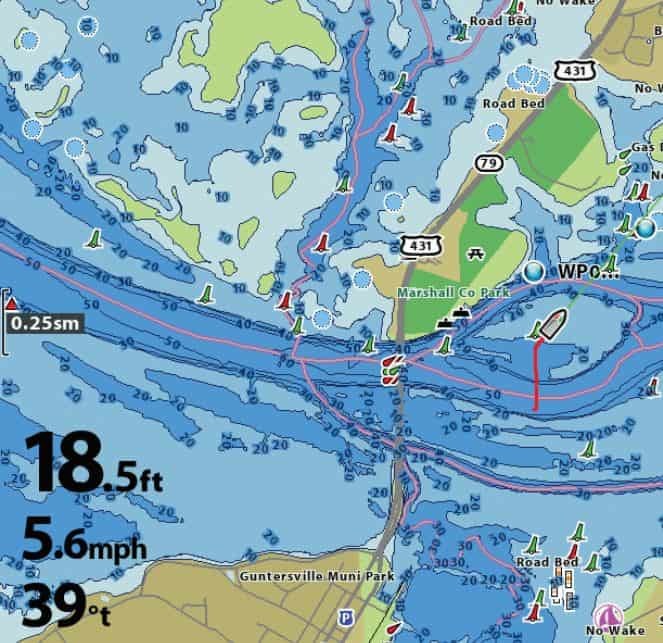
Humminbird Basemaps provide a foundational level of detail that includes underwater terrain, such as depth contours, along with points of interest for many lakes and coastal areas. These basemaps are quite useful for general navigation and fishing, offering a clear view of the water body’s structure. However, the level of detail may not be sufficient for more serious anglers who require enhanced features and greater precision.
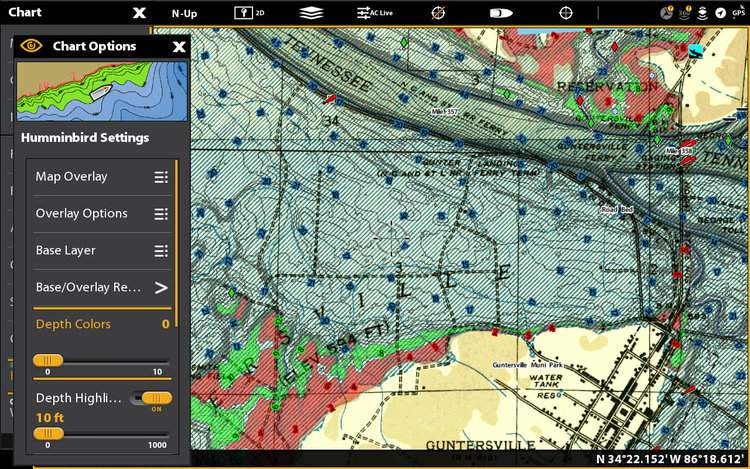
Upgrading to LakeMaster or Navionics maps can be well worth it for those who need more detailed information. LakeMaster charts, for example, offer high-definition contours with exclusive features like Depth Highlight, Shallow Water Highlight, and Water Level Offset, which can significantly aid in fishing strategy. Navionics charts also provide detailed mapping with extensive coverage and frequent updates.
Additionally, the Helix 7 has the AutoChart Live feature, which allows users to create real-time custom maps of their fishing spots, showing depth contours, bottom hardness, and vegetation. This real-time mapping is especially useful for locating the best fishing locations and understanding the underwater topography of uncharted or poorly mapped waters.
Helix 7 Variants
Here is a brief overview of the latest and main variants within the Helix 7 line:
- Helix 7 CHIRP GPS G4N: These models feature CHIRP Digital Sonar for improved target separation and reduced noise for a clearer image. They include GPS mapping capabilities but do not have Side or Down Imaging.
- Helix 7 CHIRP SI GPS G4: These units provide CHIRP Sonar, basic Side and Down Imaging, and GPS mapping, allowing anglers to see structure and fish below and to the sides of the boat.
- Helix 7 CHIRP MEGA DI GPS G4/G4N: These models have CHIRP Sonar and MEGA Down Imaging with enhanced clarity and detail below the boat, along with GPS mapping.
- Helix 7 CHIRP MEGA SI GPS G4/G4N: These are equipped with CHIRP Sonar, MEGA Side Imaging, and MEGA Down Imaging for the clearest images on both sides and directly beneath the boat. They also include GPS mapping capabilities.
The “G4” indicates the 4th generation of the Helix series, and models with “N” at the end (G4N) indicate networking capabilities, allowing for sharing data with other devices. Each model’s specific capabilities cater to different fishing techniques, water bodies, and user preferences.
Helix 7 Transducers
Here’s a chart of the compatible transducers for the Helix 7 models:
| Helix 7 Model | Transducer | |||
| Transom Mount | Trolling Motor | In-Hull | Portable | |
| HELIX 7 MEGA SI GPS | XNT 9 HW MSI 150 T | XTM 9 HW MSI 150 T | – | – |
| HELIX 7 MEGA DI GPS | XNT 9 HW MDI 75 T | XTM 9 HW MDI 75 T | – | – |
| HELIX 7 CHIRP GPS | XNT 9 HW T | XTM 9 HW T | XP 9 HW T | XPT 9 HW T |
| HELIX 7 CHIRP SI GPS | XNT 9 HW SI T | – | – | – |
Transducer Details:
- XNT 9 HW MSI 150 T: This is designed for Mega Side Imaging and provides a wide, 150-degree sonar coverage area. It offers detailed images to the side of the boat and includes a temperature sensor.
- XNT 9 HW MDI 75 T: This transducer is for Mega Down Imaging with a 75-degree coverage area, providing clear images of the water column and structures directly below the boat. It also comes with a built-in temperature sensor.
- XNT 9 HW T: A versatile transducer for CHIRP sonar, it supports High Wide Range sonar with Dual Spectrum capabilities, allowing the angler to switch between wide and narrow sonar beams. It includes a temperature sensor for monitoring water temperature.
- XNT 9 HW SI T: This transducer is suitable for CHIRP Side Imaging, providing high-resolution images to the sides of the boat. Like the others, it also has a temperature sensor to provide real-time water temperature data.
Mounting Options
Here are the mounting Options for Helix 7 Transducers:
- Transom Mount (XNT): The most common and easiest to install. The transducer is attached to the back of the boat’s hull at the transom. It provides good performance at all speeds and is easily adjustable.
- Trolling Motor Mount (XTM): This option involves mounting the transducer to the body of a trolling motor. It is an ideal location for anglers who rely on their trolling motor for boat positioning and want sonar readings directly from the front of the boat.
- In-Hull Mount (XP): This method involves mounting the transducer inside the boat hull against the bottom. This option only works with fiberglass hulls and is not suitable for all transducer types, especially Side and Down Imaging transducers.
- Portable Mount (XPT): Portable transducers can be mounted on wood, aluminum or fiberglass boats using heavy-duty suction cup. This option is great for anglers who fish from small boats or change boats frequently.
FAQs
What is the difference between Helix 7 G4 vs G3
The Humminbird Helix 7 G4 is an updated version of the G3 series. The G4 units come with improved display resolution and brightness. They also include an upgraded user interface for easier navigation and control.
What are the mounting options for the Humminbird Helix 7 display unit?
The Humminbird Helix 7 display unit can be mounted using several options:
- Gimbal Mount: A bracket mount that allows for adjustment of the display angle for optimal viewing. This is the standard mount that typically comes with the unit.
- In-Dash Mount: For a more permanent and integrated look, the unit can be flush-mounted in the dashboard of the boat.
- RAM mount: It is a versatile and durable mounting system that uses a ball and socket design allowing for almost infinite adjustment to achieve the perfect viewing angle. Particularly useful on a boat where conditions can require frequent adjustments to the viewing angle of the display unit.
- Portable Mount: Some anglers opt for portable mounts that can be used when a non-permanent installation is preferred, such as on rental boats or when switching between different vessels.
How to Use Humminbird Helix 7?
To use the Humminbird Helix 7, follow these general steps:
- Mount and Connect: Securely mount the display unit on your boat using a suitable mount, and connect it to the transducer and power source.
- Power On: Turn on the unit and allow it to initialize.
- Set Up: Configure basic settings like language, units (imperial/metric), and time. The setup wizard guide you through this the first time.
- Select Sonar Mode: Choose from various sonar modes such as Down Imaging, Side Imaging, or CHIRP sonar, depending on what you want to observe.
- Adjust Settings: Fine-tune the sonar settings such as sensitivity, noise filters, and range for optimal imaging.
- Read the Display: Interpret the sonar returns on the screen to locate fish and underwater structures.
- Use GPS and Maps: Utilize the built-in GPS to navigate and mark waypoints. You can also view and create maps with AutoChart Live.
- Adjust as Necessary: Based on conditions and what you’re seeing, adjust the view and settings as needed.
How to Read Humminbird Helix 7?
Reading the Humminbird Helix 7 involves understanding a few key elements of the display:
- Depth: The depth of the water is usually displayed at the bottom of the screen.
- Temperature: The water temperature can also be seen at the bottom, which can help determine fish activity levels.
- Speed: Your boat’s speed is important for certain types of fishing and is displayed on the screen.
- Side Imaging: For side imaging, look for dark and light areas; dark areas often mean water, and lighter areas can indicate structure or fish. Fish might appear as small, white dots or dashes.
- Down Imaging: Directly beneath the boat, it will show a more detailed view of the bottom. Structures and fish will be more defined compared to traditional sonar.
- Traditional Sonar: Displays a history of the water column beneath the boat, with fish typically appearing as arches and the bottom as a solid line.
- GPS and Maps: Your position and waypoints will be on a map display, which can be split-screen with sonar views.
- Menus and Settings: Use the menu to adjust settings like sensitivity, contrast, and sonar beams. The Helix 7 is designed to be intuitive, with menus that are navigated using keypad and buttons.
What is the best battery for Humminbird Helix 7?
Humminbird Helix 7 fish finder requires a power input of 10 to 20 VDC and has a current draw of 850 mA. The best battery would be a 12-volt deep-cycle marine battery with sufficient amp-hour (Ah) rating to provide long-lasting power.
Given the 850 mA (0.85 A) current draw, a battery with a higher Ah rating will give you more hours of use. For example, a 12V 20Ah battery could theoretically run the device for over 23 hours ([20Ah / 0.85A] = 23.5 hours), but in practice, you should aim for a larger capacity to account for real-world inefficiencies and to avoid discharging the battery completely, which can shorten its lifespan.
Look for a reliable and reputable brand that offers AGM (Absorbed Glass Mat) batteries, as they are maintenance-free and leak-proof. Ensure also that the battery you choose is suitable for the type of boat and space you have available. It’s also advisable to have a proper marine battery charger to maintain the battery’s health and longevity.

